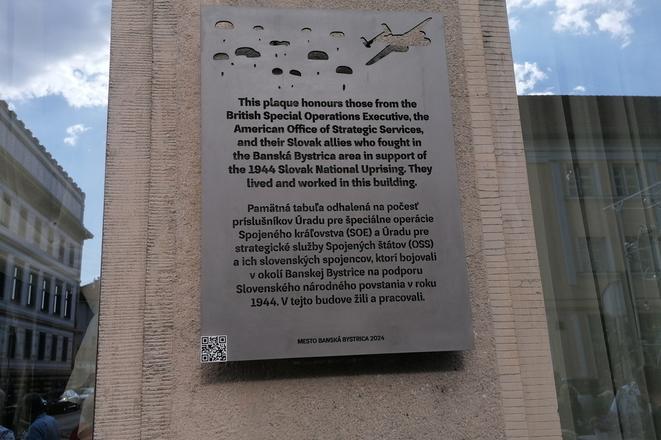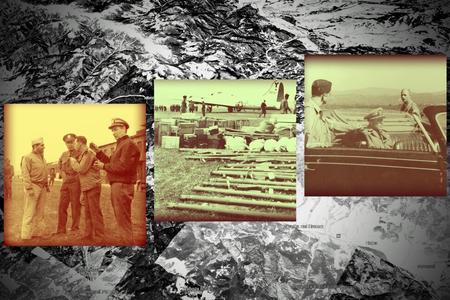The contribution of British and American special forces to the 1944 Slovak National Uprising (SNP) was marked at a ceremony in the central-Slovak city of Banská Bystrica on Thursday, September 5.
The Mayor of Banská Bystrica, Ján Nosko, alongside British Ambassador Nigel Baker and US Ambassador Gautam Rana, unveiled a commemorative plaque honouring special forces operatives from Britain's Special Operations Executive (SOE) and America's Office of Strategic Services (OSS) who were dropped into central Slovakia in September and October 1944 to assist the insurgents. Following the collapse of the SNP in late October 1944, most were captured by Nazi forces and later executed.
Also in attendance was SNP veteran Vladimír Štrmeň, 96, who gave an impassioned speech about the importance of the struggle for freedom.
The OSS was the precursor of the Central Intelligence Agency (CIA). Its 1944 mission to Slovakia was later described in an internal CIA publication as "the worst single defeat suffered by US spies in World War II".
The British and American officers were sent in as liaison missions. The US operation, which involved B-17 bombers flying from Allied-occupied Italy, was officially launched to evacuate downed allied airmen who had been stranded in Slovakia during the war, but also landed some 50 tons of military and other supplies. The British officers and their equipment were dropped by parachute.
By the time the SOE and OSS servicemen arrived, the uprising was already under severe pressure from German forces and would be defeated within a matter of weeks. After Banská Bystrica was occupied, the Americans and British, along with hundreds of Slovak partisans, retreated in small groups to the forests and mountains of central Slovakia at the start of what turned out to be a brutally cold winter. Most were eventually killed or captured.
The new commemorative plaque was unveiled at the Národný Dom Hotel in central Banská Bystrica, where some of the operatives were based during the uprising.
In a speech at the ceremony, British Ambassador Nigel Baker paid tribute to the Allied servicemen's sacrifice and read a message from James Sehmer, the 81-year-old son of Major John Sehmer, MBE, the leader of the British mission. Major Sehmer was executed at Mauthausen concentration camp in January 1945.
"I believe that these memorials ... are very important. It is entirely appropriate that our young people are reminded of the sacrifices that their forebears made for the benefit of later generations. These historical events must not be allowed to be forgotten," James Sehmer wrote.
15-year push to get plaque installed
The SNP is a crucial but politically contested event in Slovakia's history. Banská Bystrica, which hosts a museum dedicated to its memory, embraces its role as the centre of the uprising. But in 2013 Banská Bystrica Region, which includes the city, unexpectedly elected a neo-fascist politician, Marian Kotleba, as governor, suggesting that popular opinions are less than settled. His party celebrates the regime of Father Jozef Tiso, president of the wartime Slovak State, which the insurgents were seeking to depose.
Ambassador Baker credited British expat and long-time Banská Bystrica resident John Skelton with proposing and then pursuing the project to place a plaque in the city.
Speaking to The Slovak Spectator, Skelton said the project had been more than 15 years in the making, and had sometimes been a struggle in the light of the resurgence of the far-right in local and national politics. Kotleba lost his bid for re-election as regional governor in 2017, but was elected to the national parliament in 2016, where he remained until 2022.
Skelton said the city administration had become more supportive in recent years, which along with the involvement of the British and American Embassies, helped to bring about the September 5 installation of the plaque.
In comments to The Slovak Spectator, Mayor Ján Nosko stressed the importance of explaining to young people the SNP's complexity as a historical event, and the hardships endured by those who participated in the uprising. He said that sparking people's interest in the events of SNP was crucial to ensuring the horrors of that time are not repeated.
In public remarks at the ceremony to unveil the plaque, US Ambassador Gautam Rana made a similar point, lauding the heroism of Vladimír Štrmeň and drawing a parallel between Allied support for Slovaks' struggle for self-determination in 1944 and today's support by America and its allies, including Britain and Slovakia, for Ukraine in resisting present-day Russian aggression.




